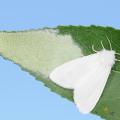Periodical Cicadas to Emerge Soon
Blake Layton, Ph.D.
Extension Entomology Specialist, Mississippi State
This spring residents of around 17 counties in Northeastern Mississippi will see, and hear, an emergence of periodical cicadas. This is not something that happens every year, and it is not something that occurs everywhere in the state. An emergence of periodical cicadas is one of the rarest and most amazing natural phenomena in the insect world. Periodical cicadas only occur in eastern North America. Broods of 17-year cicadas occur in more northern areas of this range, while here in the South we have 13-year cicadas.
There are only three broods of 13-year cicadas in the world and Mississippi is the only state where all three broods occur. Roman numerals are traditionally used to designate the different broods. Brood XIX will emerge this year, brood XXII will emerge in the Southwest corner of the state in 2027, and Brood XXIII will emerge in much of the western part of the state in 2028. Each brood takes 13 years to complete a generation, but each of these three broods is on a different emergence schedule.
Brood XIX is the largest of all broods and will occur in parts of 14 other states this year, as well as in eastern Mississippi. Brood XIII seventeen-year cicadas will also emerge this year in northern Illinois and portions of surrounding states.
With their red eyes, black bodies and orange-veined wings, periodical cicadas are easy to distinguish from the green-colored annual cicadas we see every year. They also emerge earlier in the year than annual cicadas, but it is their huge numbers and the loud singing of the males that make them so conspicuous. In ideal habitats populations can exceed one million cicadas per acre and the combined singing of hundreds of thousands of males can make it difficult to carry on a normal conversation. Residents of such areas are often relieved when an emergence has run its course, “I was so tired of that constant noise!” Cicadas do not sing at night, but males are eager to resume singing the next day.
Where do all these things come from? They literally pop up out of the ground. Periodical cicadas spend most of their lives underground as nymphs feeding on the roots of hardwood trees. They are here every year, but they are only noticed during years when adults emerge. Let’s begin the life cycle with the adults, which live about three or four weeks. The males sing to attract a female, the females deposit their eggs in pencil-sized twigs, and the adults then die, leaving the eggs of the next generation to carry on the cycle. The eggs hatch in about six weeks, and the tiny nymphs fall to the ground, dig into the soil, and search for a tree root to feed on. After 13 years of feeding on sap from tree roots, the nymphs move near the soil surface in preparation for emergence. When they sense the time is right, based on soil temperature and other cues, the nymphs will emerge, leaving ½ inch diameter holes in the ground; crawl a few feet up a tree trunk; molt one last time, leaving their empty nymphal skins attached to the tree; and move higher into the trees to enjoy their brief life as adults.
Where and when will they emerge? Periodical cicadas are expected to emerge in about 17 Mississippi counties in the northeast region of the state. But brood XIX, also known as the “Great Southern Brood,” is the largest of all broods and will also occur in parts many other states: Arkansas, Alabama, Georgia, Tennessee, Louisiana, Kentucky, Missouri, North Carolina, South Carolina, Virginia, Illinois, Indiana, and Oklahoma. This year Illinois will have 13-year cicadas emerging in the southern part of the state and 17-year cicadas in the north, something that only happens every 221 years—do the math.
Interestingly, there are some Mississippi counties, like those in the coastal and southeastern part of the state, that never have periodical cicadas, while there are a few counties that host two broods of 13-year cicadas, Brood XXIII and one of the other two broods. For example, Brood XIX occurs in eastern Oktibbeha County and Brood XXIII occurs on the west side of the county.
Whether or not you see and hear periodical cicadas in your neighborhood also depends on what the surrounding vegetation is like. You won’t find cicadas emerging from tilled fields or pasture, pine plantations, or hardwood swamps that experience prolonged flooding, but upland hardwood forests can support amazingly high populations and urban landscapes with large hardwood trees can also host cicadas.
Here in Mississippi emergence will likely begin in late April and the woods will be thrumming with periodical cicadas through much of May, with numbers declining toward the end of the month. By mid-June the songs of periodical cicadas will be replaced by those of annual cicadas. However, weather conditions can affect the timing of emergence.
What species are they? Surprisingly there is more than one species of 13-year cicada, but they all emerge at the same time. Brood XIX actually consist of four species: Magicidada tredecim, M. tredecassini, M tredecula, and M. neotredecim. These species differ subtly in size, coloration, and morphology, but the mating songs of the males sound distinctly different, especially to female cicadas. Other broods of 13-year cicadas contain these same species, but 17-year cicadas belong to one of three different species.
Are periodical cicadas dangerous? Although, their black and orange color certainly suggests they might be dangerous, cicadas are neither venomous nor poisonous. In fact, they are eagerly eaten by many birds, reptiles, and mammals, and even a few people. The warning colors are all bluff; periodical cicadas defend themselves from predators by overwhelming them with numbers, a defense strategy ecologists call “predator satiation.” There are just so many cicadas the racoons, possums, birds and other predators just can’t eat them all before they can reproduce.
The ovipositor of the female may look like a stinger, but it is better at penetrating tree bark than human skin. I have never known anyone who had their skin pierced by a cicada ovipositor. People do sometimes report experiencing a sharp pin-prick from the mouthparts of cicadas, but this is rare and only occurs when handling the insects.
Will these cicadas damage plants? Yes, but in a rather unusual way. Female cicadas use their strong, knife-like ovipositors to insert their eggs into the pencil-sized twigs of hardwood trees. These egg-laying slits sometimes cause the twigs to break, usually about six to twelve inches from the end. This results in a hanging brown “flagged twig.” By late May hardwood trees in areas where cicadas occurred will be brown with flagged twigs.
Although this ragged tip pruning does not cause serious long-term damage to mature hardwoods, it can be detrimental to young, recently planted shade trees and fruit and nut trees growing in home lawns and commercial landscapes, orchards, and nurseries. Gardeners may want to take steps to protect young trees that are especially valued or vulnerable. For example, if your back yard is bordered by an oak-hickory forest and you have some young hardwood or fruit trees that are just getting established, you may want to protect these trees.
The only effective way to protect such trees is to cover them with some type of netting that has a small enough mesh to exclude cicadas (Some bird netting is small enough; some is not.). Obviously, this requires preventive planning and a good bit of work, which is why such protective measures are usually limited to small, high value trees. With the possible exception of commercial orchards and nurseries, spraying with insecticides is not a practical or effective way to protect trees from cicada injury.
More Information: To learn even more about periodical cicadas, check out the Cicada Mania website. This site is devoted solely to cicadas and contains information and distribution maps for all know broods, including both 13-year and 17-year broods.
Publications
News
A grant from Coast Electric will allow for a renovation of the Mississippi State University Crosby Arboretum’s pollinator garden. Pat Drackett, director of the arboretum, said the pollinator garden was established in 2001 as the Explorers’ Garden. It is a 3,000-square-foot space with a variety of native and other plants that helps teach visitors how to create havens for pollinators.
The 2020 Fall Flower & Garden Fest will be a virtual, educational event this year.
A tent for camping in the woods can be a good thing, but a tent filled with caterpillars in a pecan tree can be bad news for homeowners.
Success Stories
Robin Whitfield, who gave the child the paper, stands awestruck, watching her friend’s daughter use the flower to draw and color on the page.




